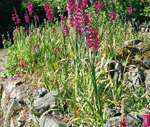Planting Cornish hedges
Mark Griffiths finds himself particularly enjoying the higgledy piggledy charm of Cornish hedges, and longs to take it home


Some say a ‘Cornish hedge’ is a free-standing bank of soil whose sides are reinforced with rocks. Others say it’s a double-layered stone wall whose cavity and fissures are filled with earth. The result looks the same to me either way. The stones involved are usually granite boulders and/or wedges of slate. The soil is that magical mixture of silty clay, sandy loam and moorland peat in which the Duchy abounds.
It sounds like a strangely linear and perpendicular rock garden, and that’s what Cornish hedges soon become. Sometimes, they’re given a helping hand, with conventional hedges planted atop them. More often than not, however, the furnishings are left to Nature a peculiarly generous and eclectic planter hereabouts. The hedges’ crests and slopes are swiftly colonised by native species and garden escapes, indigenous and exotic cohering in casual plant communities that are among the greatest beauties of the Cornish landscape.
One hedge I’ve been watching plays host to gorse, daffodils, primroses, heather, white stitchwort, bluebells, red campion, and sea campion among its British components, and, among the aliens, to Petasites fragrans and Centranthus ruber from the Mediterranean; Mexican fleabane and South American Fuchsia magellanica; South African Osteospermum, Crocosmia and Hottentot fig; Libertia grandiflora from New Zealand; and that soaring denizen of the Canaries, Echium wildpretii. Nobody would be mad or brave enough to plant all of these together, let alone in the crevices of an exposed bank; yet they thrive, an improbable impromptu garden 20 yards long and barely two yards wide and high. Only the cost of granite outside Cornwall will curb my yearning to reproduce it when I return to the Saxon realm later this summer.
There is one other notable coloniser of the Cornish hedge, and of almost any sunny fast-draining niche, come to that a flower that has caused small scale chaos here in the past few weeks as coaches hurtle to a halt on the command of tourists who cannot believe their eyes. It is Gladiolus communis subsp byzantinus, a Mediterranean native known to English gardeners since the 16th century as corn flag, and to the Cornish as whistling Jack, a name nobody seems able to explain. Still more mysterious is how it came to Cornwall.
* For more gardening advice like this every week subscribe and save
The commonly accepted theory is that the gladiolus escaped from cut-flower fields, an industry in which it has certainly played a part. And yet whistling Jacks are so comprehensively naturalised and so varied that it’s hard to believe that they could all have come from nursery stock that jumped the hedge some time between 1880 and 1950. For every Cornishman who claims they did, a half-dozen more will say they’ve been here since before records began. Gladiolus communis subsp byzantinus was a favourite of the Tudor and Jacobean gardening elite, which may explain its presence in Cornwall at an earlier date, but then those same grandees had relatively little to do with the far South-West.
Unlike the charming Gladiolus illyricus, which grows truly wild in the New Forest, it would be stretching things to argue that whistling Jacks were ever native here. They may, however, owe their arrival to earlier waves of traders, invaders and raiders. Between Phoenician merchants, Roman colonisers and Spanish pirates, the window of opportunity was enormous. Similar interactions have been used to explain another such mystery the Tenby daffodil, isolated in south-west Wales and most closely related to plants found wild in central Spain.
Sign up for the Country Life Newsletter
Exquisite houses, the beauty of Nature, and how to get the most from your life, straight to your inbox.
Not that whistling Jacks really need this buccaneering romance. However they came here, these gladioli are now as Cornish as clotted cream. They’re also the loveliest of all the hedge’s inhabitants. Nothing could be further from Dame Edna’s darlings than their slender and slightly inclined spikes of silken magenta blooms.
In the past few weeks, I’ve glimpsed them growing in ways that I will copy when the time comes for me to return ‘up-country’, hedge or no hedge scattered through a meadow of ox-eye daisies, for example, or with Chrysanthemum segetum, corn flag with corn marigold in a Klimtian cloud of purple and gold, or even paired with the rampageous grass Phalaris arundinacea Picta, burgundy butterflies hovering among white-striped blades.
* For more gardening advice like this every week subscribe and save
Country Life is unlike any other magazine: the only glossy weekly on the newsstand and the only magazine that has been guest-edited by HRH The King not once, but twice. It is a celebration of modern rural life and all its diverse joys and pleasures — that was first published in Queen Victoria's Diamond Jubilee year. Our eclectic mixture of witty and informative content — from the most up-to-date property news and commentary and a coveted glimpse inside some of the UK's best houses and gardens, to gardening, the arts and interior design, written by experts in their field — still cannot be found in print or online, anywhere else.
-
 A rare opportunity to own one a family home on Vanbrugh Terrace, one of London's finest streets
A rare opportunity to own one a family home on Vanbrugh Terrace, one of London's finest streetsThis six-bedroom Victorian home sits right on the start line of the London Marathon, with easy access to Blackheath and Greenwich Park
By James Fisher
-
 Materials, textures, construction, expression: A Brutalist watch on your wrist
Materials, textures, construction, expression: A Brutalist watch on your wristLuxury watchmakers are seeking to bridge the gap between two contrasting styles, with exciting results.
By Chris Hall